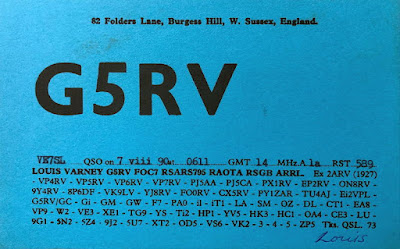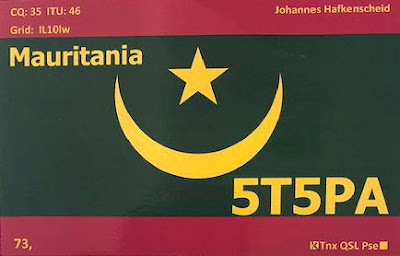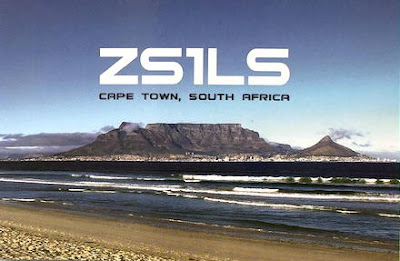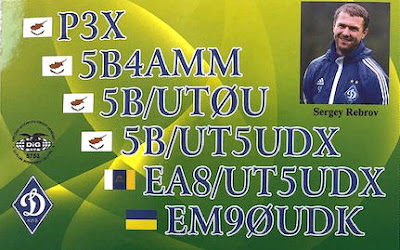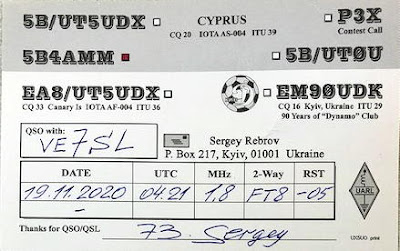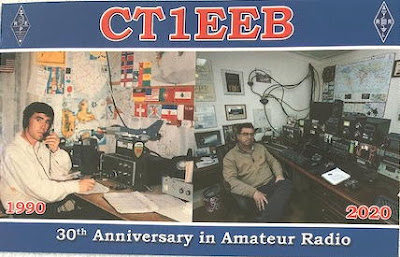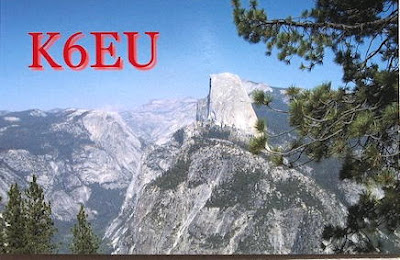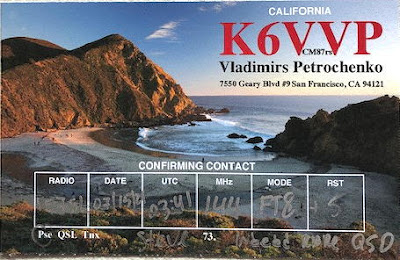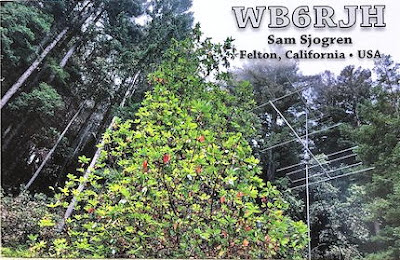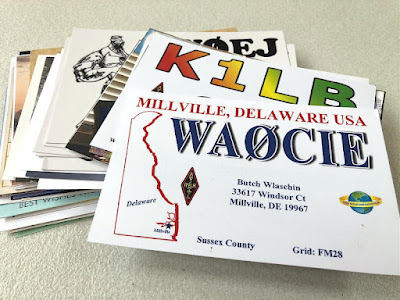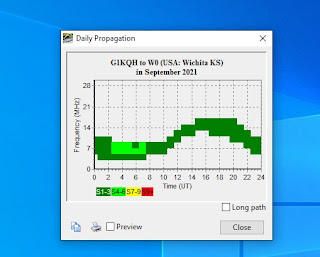 My Summer QSL Mailbox
My Summer QSL Mailbox
Most of my blog readers know how much I love QSLs ... real paper ones that is. In fact the lure of collecting cards was one of the main things that hooked me on radio as a pre-teen SWL!
All of the important QSLs from last winter’s 160m DX season have finally arrived along with cards for the new ones worked during this summer’s Sporadic E season on 6m … plus some other cards of interest.
Both seasons provided some good DX opportunities and several new DXCC entities were added to my totals. In fact the new countries worked this summer on the magic band finally gave me 100 confirmed for DXCC after being on the band since Cycle 20! This summer was probably the best I’ve ever seen in terms of long haul propagation to Europe and Japan. Sadly almost all of the activity is on FT8 even though signals were usually more than strong enough for CW (and sometimes SSB) modes. Hopefully the band will once again see more of these traditional modes as the solar cycle progresses.
The Top Band season was highlighted with a nice three-week period of exceptionally good propagation to many parts of Europe and regions beyond. Four new DXCC countries were added to my total bringing my 160m DXCC to 163 confirmed.
Some additional 630m band wallpaper also arrived over the summer from Arliss, W7XU. In mid-April, well-past the prime DX season, he ventured from his normal QTH in South Dakota to become W7XU/5 in Louisiana. I never in the world expected to even hear his small portable campground station let alone work him, but his signal was truly outstanding and we worked very quickly. Arliss gave me state #38 on 630m. We worked each other a few months later but this time on 2m during the August Perseids meteor shower when he was back at home in South Dakota.
The evening of July 15th produced a rarity for VE7 land … a short Sporadic E opening to California on 2m.
Four stations in and around the San Francisco region were worked with several of the signals being exceptionally strong, often the case on 2m Es.
And lastly, all 50 cards for last winter’s 40m Worked All States project were gathered over the summer months. All contacts were made using my homebrewed 1-tube Neophyte regen along with its matching 1-tube crystal oscillator.
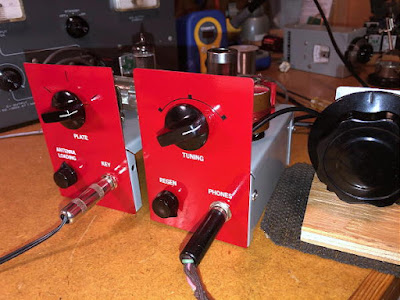 |
| Neophyte Twins with outboard bandspread on the regen |
I’ve now parked the pair on 3560 for the winter while I attempt to repeat the challenge of working and confirming all 50 states. With 7 so far, I’m looking for 43 more! If you can help out with a listen (I’m on most evenings) or with a sked, I’d love to work you on 80m with the 1-tubers.
Did I mention that I really love QSLs?
Steve McDonald, VE7SL, is a regular contributor to AmateurRadio.com and writes from British Columbia, Canada. Contact him at [email protected].
 VOAPROP configuring 2021
VOAPROP configuring 2021
Once you have all this updated, the program will perform flawless without any problem.
My thanks must be to the late G4ILO for writing such a superb piece of software, and his family that still keep his website open https://www.g4ilo.com/
Steve, G1KQH, is a regular contributor to AmateurRadio.com and writes from England. Contact him at [email protected].
 Remember what it was like without it all?
Remember what it was like without it all?
Steve, G1KQH, is a regular contributor to AmateurRadio.com and writes from England. Contact him at [email protected].
 LHS Episode #433: Mind the Spark Gap
LHS Episode #433: Mind the Spark Gap
Hello and welcome to the 433rd installment of Linux in the Ham Shack. In this short-topics episode, the hosts discuss several topics including RaDAR, communicating across the Atlantic in the early days of radio, taxing open-source satellites, open source and Azure, the latest release of WSJT-X and much more. Thank you for listening and have a great week.
73 de The LHS Crew
Russ Woodman, K5TUX, co-hosts the Linux in the Ham Shack podcast which is available for download in both MP3 and OGG audio format. Contact him at [email protected].
 Get Your General License, Colorado
Get Your General License, Colorado
 The Technician Class License is the entry-level ham radio license in the USA. The next step up is the General Class License which provides operating privileges on the high-frequency bands. If you want to work the world with ham radio, you should seriously consider going for the General license.
The Technician Class License is the entry-level ham radio license in the USA. The next step up is the General Class License which provides operating privileges on the high-frequency bands. If you want to work the world with ham radio, you should seriously consider going for the General license.
The Tri-Lakes Monument Radio Association is offering a blended (online and in-person) license class to assist you in moving up to General. The class starts on Nov 6th and will have five sessions: two in-person sessions in Monument, CO plus three online sessions via Zoom. The final session is in-person and includes the FCC exam. (Complete schedule listed below.)
 The General License provides access to regional and worldwide communications on the HF bands via ionospheric skip, greatly expanding operational capabilities!
The General License provides access to regional and worldwide communications on the HF bands via ionospheric skip, greatly expanding operational capabilities!
• Upgrade from Technician to General Class radio privileges
• Pass your FCC General Class amateur license exam Nov 20
• Live equipment demonstrations and activities
• Learn to operate on the HF bands, 10 Meters to 160 Meters
• Gain a deeper understanding of radio electronics and theory
• Take the next step with antennas, amplifiers, digital modes
The registration fee is $30 ($20 for those under 18 years of age). In addition, students must have the required study guide: HamRadioSchool.com General License Course,
Third Edition, effective 2019 – 2023, $24.95. A current FCC Technician License is required for registration.
More information and registration page here: https://w0tlm.com/radio-classes/general-registration
For questions, email: [email protected]
Schedule
Session 1, Sat Nov 6, 1-5 pm: In-Person, Tri-Lakes Chamber of Commerce Meeting Room, Monument, CO. Ch.Ø-3 instruction
On-Demand Video Lesson (online video at your convenience). Ch.4 instruction
Session 2, Tue Nov 9, 6-7 pm: Live Zoom meeting. Ch.1-4 review and Q&A
Session 3, Thur Nov 11, 6-8:15 pm: Live Zoom meeting. Ch.5 instruction
Session 4, Sat Nov 13, 1-5 pm: Live Zoom meeting. Ch.6 instruction
Session 5, Sat Nov 20, 1-5 pm: In-Person, Tri-Lakes Chamber of Commerce Meeting Room, Monument, CO. Wrap-up, review, VE Exam session.
The post Get Your General License, Colorado appeared first on The KØNR Radio Site.
Bob Witte, KØNR, is a regular contributor to AmateurRadio.com and writes from Colorado, USA. Contact him at [email protected].
 Get Your General License, Colorado
Get Your General License, Colorado
 The Technician Class License is the entry-level ham radio license in the USA. The next step up is the General Class License which provides operating privileges on the high-frequency bands. If you want to work the world with ham radio, you should seriously consider going for the General license.
The Technician Class License is the entry-level ham radio license in the USA. The next step up is the General Class License which provides operating privileges on the high-frequency bands. If you want to work the world with ham radio, you should seriously consider going for the General license.
The Tri-Lakes Monument Radio Association is offering a blended (online and in-person) license class to assist you in moving up to General. The class starts on Nov 6th and will have five sessions: two in-person sessions in Monument, CO plus three online sessions via Zoom. The final session is in-person and includes the FCC exam. (Complete schedule listed below.)
 The General License provides access to regional and worldwide communications on the HF bands via ionospheric skip, greatly expanding operational capabilities!
The General License provides access to regional and worldwide communications on the HF bands via ionospheric skip, greatly expanding operational capabilities!
• Upgrade from Technician to General Class radio privileges
• Pass your FCC General Class amateur license exam Nov 20
• Live equipment demonstrations and activities
• Learn to operate on the HF bands, 10 Meters to 160 Meters
• Gain a deeper understanding of radio electronics and theory
• Take the next step with antennas, amplifiers, digital modes
The registration fee is $30 ($20 for those under 18 years of age). In addition, students must have the required study guide: HamRadioSchool.com General License Course,
Third Edition, effective 2019 – 2023, $24.95. A current FCC Technician License is required for registration.
More information and registration page here: https://w0tlm.com/radio-classes/general-registration
For questions, email: [email protected]
Schedule
Session 1, Sat Nov 6, 1-5 pm: In-Person, Tri-Lakes Chamber of Commerce Meeting Room, Monument, CO. Ch.Ø-3 instruction
On-Demand Video Lesson (online video at your convenience). Ch.4 instruction
Session 2, Tue Nov 9, 6-7 pm: Live Zoom meeting. Ch.1-4 review and Q&A
Session 3, Thur Nov 11, 6-8:15 pm: Live Zoom meeting. Ch.5 instruction
Session 4, Sat Nov 13, 1-5 pm: Live Zoom meeting. Ch.6 instruction
Session 5, Sat Nov 20, 1-5 pm: In-Person, Tri-Lakes Chamber of Commerce Meeting Room, Monument, CO. Wrap-up, review, VE Exam session.
The post Get Your General License, Colorado appeared first on The KØNR Radio Site.
Bob Witte, KØNR, is a regular contributor to AmateurRadio.com and writes from Colorado, USA. Contact him at [email protected].
 Ham College 81
Ham College 81
Ham College episode 81 is now available for download.
Extra Class Exam Questions – Part 19.
E4E Noise suppression and interference: Noise suppression and interference: system noise, electrical appliance noise, line noise, locating noise sources, DSP noise reduction, noise blankers, grounding for signals, common mode currents.
1:10:53
George Thomas, W5JDX, is co-host of AmateurLogic.TV, an original amateur radio video program hosted by George Thomas (W5JDX), Tommy Martin (N5ZNO), Peter Berrett (VK3PB), and Emile Diodene (KE5QKR). Contact him at [email protected].

